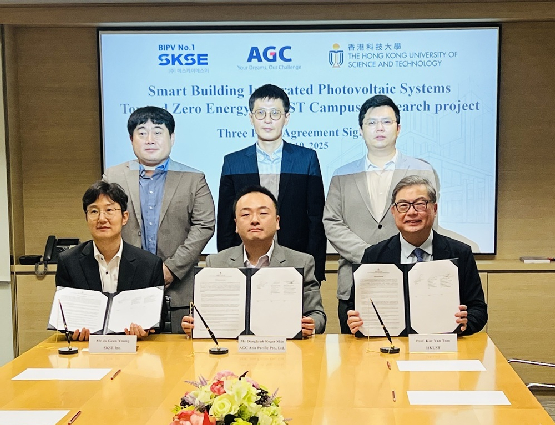

The building-integrated photovoltaic solar panels along with essential service and manpower support will facilitate advanced research and practical application in the area of net-zero building design. Under HKUST’s “Living Lab” approach to sustainable development, the panels will be installed at Tower D Staff Quarters, serving as a research hub and a demonstration of cutting-edge sustainable energy solutions retrofitting to the existing façade, while preserving the aesthetic integrity of the university’s architecture.
“This is a good example of our faculty working with international companies," said Prof. Kar Yan TAM, Vice-President for Administration and Business and Acting Vice-President for Institutional Advancement at HKUST. “Sustainability is a core priority at HKUST and it’s the reason we’re motivated to use our campus as a Living Lab to advance forward-thinking ideas for the betterment of Hong Kong and our region.”
Mr. JO Geun Young, Chief Executive Officer of SKSE Inc., and Mr. Donghyuk Roger SHIN, representative of AGC Asia Pacific Pte Ltd., expressed their enthusiasm for the project. “We are proud to contribute our expertise to advance this important initiative at HKUST and we look forward to seeing its successful completion.”
Prof. Changying XIANG, project leader of the BIPV Research Project and Director of HKUST’s Zero Carbon Architecture and Future Cities research group, emphasized the research significance, “This donation supports HKUST to pioneer Hong Kong’s first color BIPV wall renovation, which is a critical step in advancing sustainable building technologies. By promoting BIPV innovation, we’re empowering the building to become a smart, energy-generating unit, directly supporting Hong Kong’s 2050 zero-carbon goal and the vision of a sustainable smart city.”
The installation of the BIPV systems is set to begin in the Academic Year 2025 - 2026, with a target of reducing carbon dioxide emissions by 30 metric tons annually. HKUST invites further community engagement to support this vital sustainability milestone.
For additional information about the BIPV research project, please click here.

